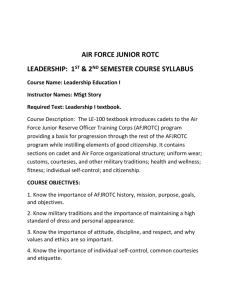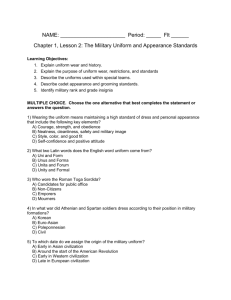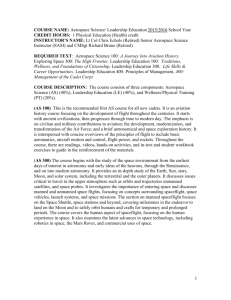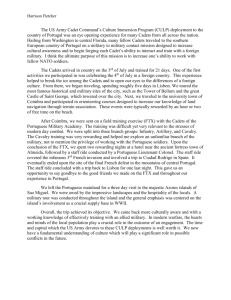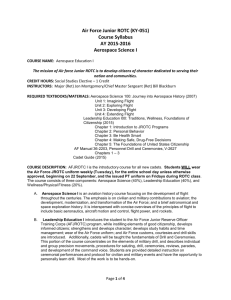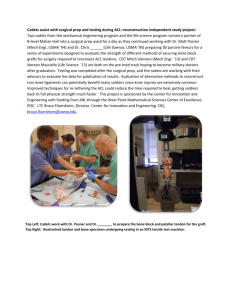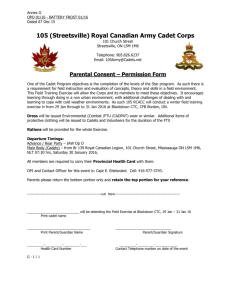TX-931, AFJROTC COURSE SYLLABUS
advertisement
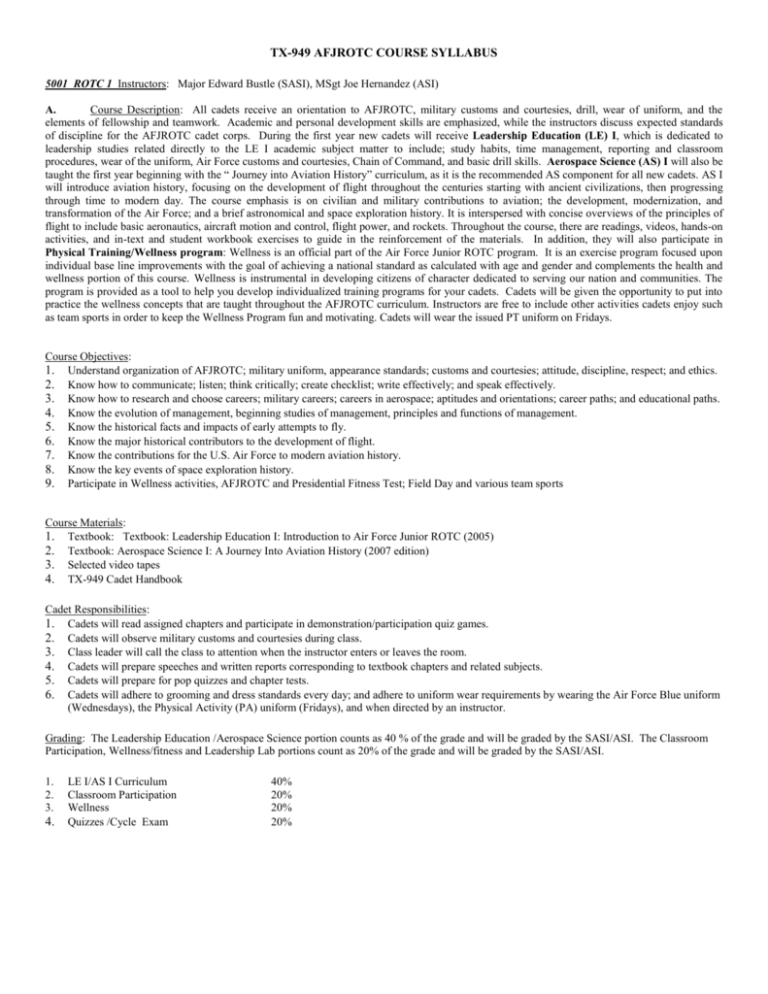
TX-949 AFJROTC COURSE SYLLABUS 5001 ROTC 1 Instructors: Major Edward Bustle (SASI), MSgt Joe Hernandez (ASI) A. Course Description: All cadets receive an orientation to AFJROTC, military customs and courtesies, drill, wear of uniform, and the elements of fellowship and teamwork. Academic and personal development skills are emphasized, while the instructors discuss expected standards of discipline for the AFJROTC cadet corps. During the first year new cadets will receive Leadership Education (LE) I, which is dedicated to leadership studies related directly to the LE I academic subject matter to include; study habits, time management, reporting and classroom procedures, wear of the uniform, Air Force customs and courtesies, Chain of Command, and basic drill skills. Aerospace Science (AS) I will also be taught the first year beginning with the “ Journey into Aviation History” curriculum, as it is the recommended AS component for all new cadets. AS I will introduce aviation history, focusing on the development of flight throughout the centuries starting with ancient civilizations, then progressing through time to modern day. The course emphasis is on civilian and military contributions to aviation; the development, modernization, and transformation of the Air Force; and a brief astronomical and space exploration history. It is interspersed with concise overviews of the principles of flight to include basic aeronautics, aircraft motion and control, flight power, and rockets. Throughout the course, there are readings, videos, hands-on activities, and in-text and student workbook exercises to guide in the reinforcement of the materials. In addition, they will also participate in Physical Training/Wellness program: Wellness is an official part of the Air Force Junior ROTC program. It is an exercise program focused upon individual base line improvements with the goal of achieving a national standard as calculated with age and gender and complements the health and wellness portion of this course. Wellness is instrumental in developing citizens of character dedicated to serving our nation and communities. The program is provided as a tool to help you develop individualized training programs for your cadets. Cadets will be given the opportunity to put into practice the wellness concepts that are taught throughout the AFJROTC curriculum. Instructors are free to include other activities cadets enjoy such as team sports in order to keep the Wellness Program fun and motivating. Cadets will wear the issued PT uniform on Fridays. Course Objectives: 1. Understand organization of AFJROTC; military uniform, appearance standards; customs and courtesies; attitude, discipline, respect; and ethics. 2. Know how to communicate; listen; think critically; create checklist; write effectively; and speak effectively. 3. Know how to research and choose careers; military careers; careers in aerospace; aptitudes and orientations; career paths; and educational paths. 4. Know the evolution of management, beginning studies of management, principles and functions of management. 5. Know the historical facts and impacts of early attempts to fly. 6. Know the major historical contributors to the development of flight. 7. Know the contributions for the U.S. Air Force to modern aviation history. 8. Know the key events of space exploration history. 9. Participate in Wellness activities, AFJROTC and Presidential Fitness Test; Field Day and various team sports Course Materials: 1. Textbook: Textbook: Leadership Education I: Introduction to Air Force Junior ROTC (2005) 2. Textbook: Aerospace Science I: A Journey Into Aviation History (2007 edition) 3. Selected video tapes 4. TX-949 Cadet Handbook Cadet Responsibilities: 1. Cadets will read assigned chapters and participate in demonstration/participation quiz games. 2. Cadets will observe military customs and courtesies during class. 3. Class leader will call the class to attention when the instructor enters or leaves the room. 4. Cadets will prepare speeches and written reports corresponding to textbook chapters and related subjects. 5. Cadets will prepare for pop quizzes and chapter tests. 6. Cadets will adhere to grooming and dress standards every day; and adhere to uniform wear requirements by wearing the Air Force Blue uniform (Wednesdays), the Physical Activity (PA) uniform (Fridays), and when directed by an instructor. Grading: The Leadership Education /Aerospace Science portion counts as 40 % of the grade and will be graded by the SASI/ASI. The Classroom Participation, Wellness/fitness and Leadership Lab portions count as 20% of the grade and will be graded by the SASI/ASI. 1. 2. 3. 4. LE I/AS I Curriculum Classroom Participation Wellness Quizzes /Cycle Exam 40% 20% 20% 20% TX-949 AFJROTC COURSE SYLLABUS 5002 ROTC 2 Instructors: Major Edward Bustle (SASI), MSgt Joe Hernandez (ASI) B. Course Description: All cadets receive an orientation to AFJROTC, military customs and courtesies, drill, wear of uniform, and the elements of fellowship and teamwork. Academic and personal development skills are emphasized, while the instructors discuss expected standards of discipline for the AFJROTC cadet corps. Cadets receive Leadership Education II in their second year: Covering communication skills and Cadet Corps activities. Written reports and speeches compliment academic materials. Cadet Corps activities include holding positions of greater responsibility in the planning and execution of corps projects. Aerospace Science II will also be taught in the second year, The Science of Flight: Designed to acquaint the student with the aerospace environment, the human requirements of flight, principles of aircraft flight, and principles of navigation. The course begins with a discussion of the atmosphere and weather. After developing an understanding of the environment, how that environment affects flight is introduced. Discussions include the forces of lift, drag, thrust, and weight. Students also learn basic navigation including map reading, course plotting, and the effects of wind. The portion of the Human Requirements of Flight is a survey course on human physiology. Discussed here are the human circulatory system, the effects of acceleration and deceleration, and protective equipment. Readings are also available to set the stage for each lesson, or homework assignments. In addition, they will also participate in Physical Training/Wellness program: Wellness is an official part of the Air Force Junior ROTC program. It is an exercise program focused upon individual base line improvements with the goal of achieving a national standard as calculated with age and gender and complements the health and wellness portion of this course. Wellness is instrumental in developing citizens of character dedicated to serving our nation and communities. The program is provided as a tool to help you develop individualized training programs for your cadets. Cadets will be given the opportunity to put into practice the wellness concepts that are taught throughout the AFJROTC curriculum. Instructors are free to include other activities cadets enjoy such as team sports in order to keep the Wellness Program fun and motivating. Cadets will wear the issued PT uniform on Fridays. Course Objectives: 1. Know the basic human requirements of flight. 2. Know why Bernoulli’s principle and Newton’s Laws of Motion are applied to the theory of flight and the operating principles of reciprocation engines, jet engines, and rocket engines. 3. Know the basic elements of navigation, the four basic navigation instruments, and the methods of navigation. 4. Comprehend the concepts of effective communication. 5. Know himself or herself in relation to others and the society in which we live. 6. Comprehend how teams work to succeed in improving quality and productivity. 7. Comprehend that leadership is a very complex art that is essential to the success of the mission. 8. Participate in Wellness activities, AFJROTC and Presidential Fitness Test; Field Day and various team sports Course Materials: 1. Textbook: Aerospace Science II: The Science of Flight (2001 edition) 2. Textbook: Leadership Education II: Communication, Awareness and Leadership (2006) 3. Selected video tapes 4. TX-949 Cadet Handbook Cadet Responsibilities: 1. Cadets will read assigned chapter and participate in demonstration/participation quiz games. 2. Cadets will observe military customs and courtesies during class. 3. Class leader will call the class to attention when the instructor enters or leaves the room. 4. Cadets will prepare speeches and written reports corresponding to textbook chapters and related subjects. 5. Cadets will prepare for pop quizzes and chapter tests. 6. Cadets will adhere to grooming and dress standards every day; and adhere to uniform wear requirements by wearing the Air Force Blue uniform (Wednesdays), the Physical Activity (PA) uniform (Fridays), and when directed by an instructor. Grading: The Leadership Education /Aerospace Science portion counts as 40 % of the grade and will be graded by the SASI/ASI. The Wellness Activity (WA) portion counts as 20% of the grade and will be graded by the SASI/ASI. 1. 2. 3. 4. Leadership /Aerospace Science Classroom Participation Wellness Quizzes /Cycle Exam 40% 20% 20% 20% TX-949 AFJROTC COURSE SYLLABUS 5003 ROTC 3 Instructors: Major Edward Bustle (SASI), MSgt Joe Hernandez (ASI) C. Course Description: All cadets receive an orientation to AFJROTC, military customs and courtesies, drill, wear of uniform, and the elements of fellowship and teamwork. Academic and personal development skills are emphasized, while the instructors discuss expected standards of discipline for the AFJROTC cadet corps. The Leadership Education III Life Skills course is taught the third year and will be helpful to students deciding which path to take after high school. Information on how to apply for admission to college or to a vocational or technical school is included. Information on how to begin the job search is available to students who decide not to go to college or vocational school. Available also is information about financial planning and how to save, invest, and spend money wisely, as well as how not to get caught in the credit trap. Students are informed about real life issues such as understanding contracts, leases, wills, warranties, legal notices, and personal bills. Citizen responsibilities such as registering to vote, jury duty, and selective service registration will be covered also. For those students who may be moving into an apartment of their own, information is presented on apartment shopping and grocery shopping skills. If there are students who are interested in a career in the military, with the federal government, or an aerospace career, information is also provided for them. Aerospace III course taught is The Exploration of Space: The course, which examines our Earth, the Moon and the planets, the latest advances in space technology, and continuing challenges of space and manned space flight. Issues critical to travel in the upper atmosphere such as; orbits and trajectories, unmanned satellites, space probes, guidance and control systems are discussed. The manned space flight section covers major milestones in the endeavor to land on the Moon, and to safely orbit humans and crafts in space for temporary and prolonged periods. It also covers the development of space stations, the Space Shuttle and its future, and international laws for the use of and travel in space. In addition, they will also participate in Physical Training/Wellness program: Wellness is an official part of the Air Force Junior ROTC program. It is an exercise program focused upon individual base line improvements with the goal of achieving a national standard as calculated with age and gender and complements the health and wellness portion of this course. Wellness is instrumental in developing citizens of character dedicated to serving our nation and communities. The program is provided as a tool to help you develop individualized training programs for your cadets. Cadets will be given the opportunity to put into practice the wellness concepts that are taught throughout the AFJROTC curriculum. Instructors are free to include other activities cadets enjoy such as team sports in order to keep the Wellness Program fun and motivating. Cadets will wear the issued PT uniform on Fridays. Course Objectives: 1. Comprehend the importance of obtaining a degree or skill after high school. 2. Know that a proper job search is needed to obtain employment. 3. Comprehend the importance of financial planning. 4. Comprehend space exploration to include history of space flight, organizations doing work in space, and the overall space environment. 5. Know and use key concepts for getting from the surface of the Earth into Earth orbit, to other planets and back again. 6. Know how spacecraft and launch vehicles, and their associated parts, are designed and built to support the needs of the United States. 7. Know techniques used to manage the development and operations of space systems within government and industry. 8. Participate in Wellness activities, AFJROTC and Presidential Fitness Test; Field Day and various team sports Course Materials: 1. Textbook: Textbook: Leadership Education III: Life Skills & Career Opportunities (2006) 2. Textbook: Aerospace Science III: The Exploration of Space (2005 edition) 3. Selected video tapes 4. TX-949 Cadet Handbook Cadet Responsibilities: 1. Cadets will read assigned chapters and participate in demonstration/participation quiz games. 2. Cadets will observe military customs and courtesies during class. 3. Class leader will call the class to attention when the instructor enters or leaves the room. 4. Cadets will prepare speeches and written reports corresponding to textbook chapters and related subjects. 5. Cadets will prepare for pop quizzes and chapter tests. 6. Cadets will adhere to grooming and dress standards every day; and adhere to uniform wear requirements by wearing the Air Force Blue uniform (Wednesdays), the Physical Activity (PA) uniform (Fridays), and when directed by an instructor. Grading: The Leadership Education /Aerospace Science portion counts as 40 % of the grade and will be graded by the SASI/ASI. The Wellness Activity (WA) portion counts as 20% of the grade and will be graded by the SASI/ASI. 1. 2. 3. 4. Leadership /Aerospace Science Classroom Participation Wellness Quizzes /Cycle Exam 40% 20% 20% 20% TX-949 AFJROTC COURSE SYLLABUS 5004 ROTC 4 Instructors: Major Edward Bustle (SASI), MSgt Joe Hernandez (ASI) D. Course Description: All cadets receive a refresher orientation to AFJROTC, military customs and courtesies, drill, wear of uniform, and the elements of fellowship and teamwork. The fourth year course study is Leadership IV, Principles of Management: The course is a guide to understanding the fundamentals of management, managing yourself, and others. Emphasis is placed on allowing the student to see themselves as managers. Every organization, regardless of size, faces the challenge of managing operations effectively. No matter how well a manager carries out his or her job, there are always ways of doing at least part of the task more effectively. There are four building blocks of leadership considered in this text from the military and civilian perspective. Attention to these four areas will form a strong foundation for a capability to lead others – something that can be very valuable to you for the rest of your life. The four areas are Management Techniques, Management Decisions, Management Functions, and Managing Self and Others. The fourth year also incorporates Aerospace Science 410 Survival/Return: The course is basic survival information instruction found in Air Force Regulation 64-4 Survival Training. The survival instruction will provide training in skills, knowledge, and attitudes necessary to successfully perform fundamental tasks needed for survival. Survival also presents “good to know” information that would be useful in any situation. The information is just as useful to an individual lost hunting or stranded in a snowstorm. Senior/Junior cadets who are exceptional leaders may hold command positions or serve as senior non-commissioned officers in key staff assignments. They are responsible for leading planning, developing, organizing, and executing Wing/Group/Flight activities, projects and programs. This option allows the cadets to manage all aspects of Corps Operations during the year. This hands-on experience affords the cadets the opportunity to put the theories of previous leadership courses into practice under the supervision of the instructors. All the planning, organizing, coordinating, directing, and decision-making will be done by the cadets. They practice their communication, decision-making, personal-interaction, managerial, and organizational skills on a daily basis and are responsible for reviewing AFJROTC military customs and courtesies, drill, wear of uniform and fostering fellowship and teamwork. In addition, all cadets will participate in a Physical Training/Wellness program: Wellness is an official part of the Air Force Junior ROTC program. It is an exercise program focused upon individual base line improvements with the goal of achieving a national standard as calculated with age and gender and complements the health and wellness portion of this course. Wellness is instrumental in developing citizens of character dedicated to serving our nation and communities. The program is provided as a tool to help you develop individualized training programs for your cadets. Cadets will be given the opportunity to put into practice the wellness concepts that are taught throughout the AFJROTC curriculum. Instructors are free to include other activities cadets enjoy such as team sports in order to keep the Wellness Program fun and motivating. Cadets will wear the issued PT uniform on Fridays. Course Objectives: 1. Comprehension of the importance of management. 2. Comprehend the techniques and skills involved in making management decisions. 3. Comprehend the concepts and skills of problem solving, decision-making, and negotiating. 4. Comprehend the importance of managing yourself and others. 5. Apply the theories and techniques learned in previous leadership courses. 6. Know how to develop leadership and management competency through participation. 7. Apply strengthened organizational skill through active incorporation. 8. Know how to develop confidence in ability by exercising decision-making skills. 9. Apply Air Force standards, discipline, and conduct. 10. Know the elements of surviving. 11. Know how medicine procedures, clothing, and shelter can provide personal protection for a survivor in a survival situation. 12. Know the necessities for maintaining life in a survival situation. 13. Know how to travel and prepare for recovery in a survival situation. 14. Participate in Wellness activities, AFJROTC and Presidential Fitness Test; Field Day and various team sports Course Materials: 1. Textbook: Leadership Education IV: Principals of Management (1999)Textbook: LE I, LE II, LE III, and LE IV 2. Textbook: Aerospace 410 Survival V7027T 3. Selected video tapes 4. TX-949 Cadet Handbook Cadet Responsibilities: 1. Cadets will read assigned chapters, and participate in demonstration/participation quiz games. 2. Cadets will observe military customs and courtesies during class. 3. Class leader will call the class to attention when the instructor enters or leaves the room. 4. Cadets will prepare speeches and written reports corresponding to textbook chapters and related subjects. 5. Cadets will prepare for pop quizzes and chapter tests. 6. Cadets will adhere to grooming and dress standards every day; and adhere to uniform wear requirements by wearing the Air Force Blue uniform (Wednesdays), the Physical Activity (PA) uniform (Fridays), and when directed by an instructor. Grading: The Leadership Education /Aerospace Science portion counts as 40 % of the grade and will be graded by the SASI/ASI. The Wellness Activity (WA) portion counts as 20% of the grade and will be graded by the SASI/ASI. 1. 2. 3. 4. Leadership /Aerospace Science Classroom Participation Wellness Quizzes /Cycle Exam 40% 20% 20% 20%
